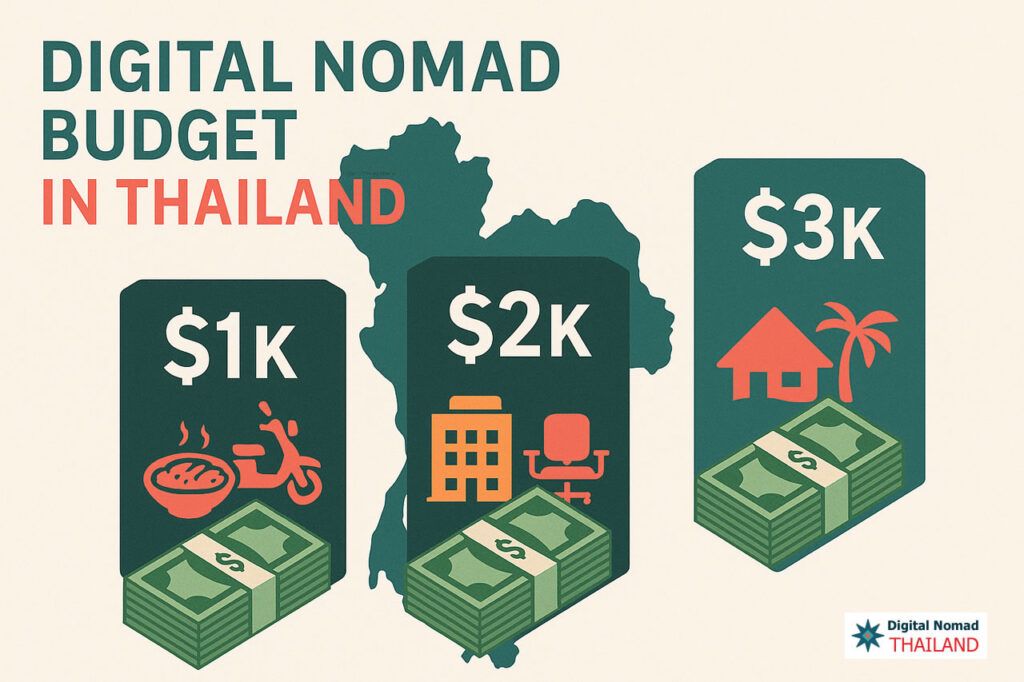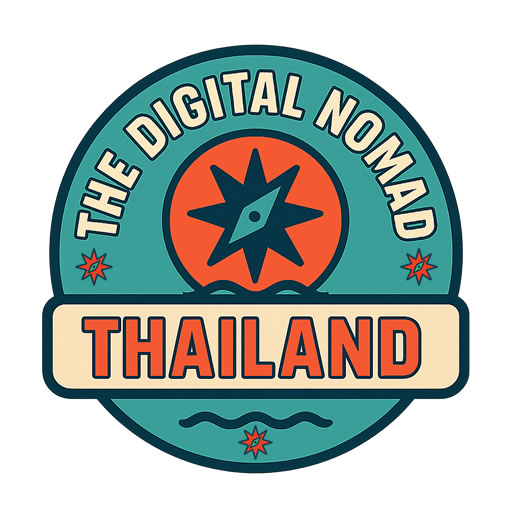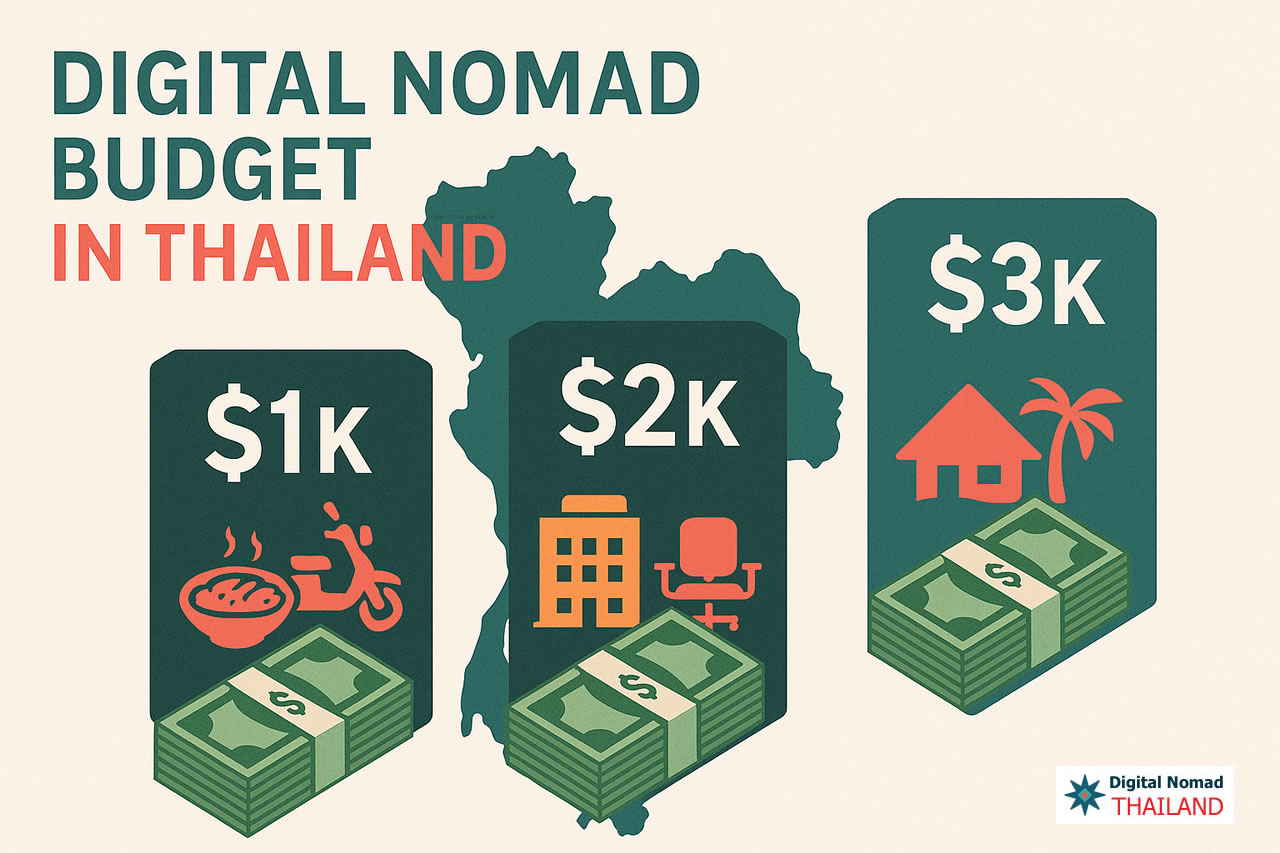
Three real-world spending tiers, not theoretical spreadsheets. Three budgets, three lifestyles — which one’s yours?
“How much does it really cost to live in Thailand as a digital nomad?”
It’s probably the first question people ask before packing a laptop and booking a one-way ticket.
The truth: you can live lean on $1,000 a month, find balance at $2,000, or enjoy premium comfort around $3,000. But each tier comes with trade-offs — from the kind of condo you rent, to whether you’re zipping around on a scooter or grabbing taxis every day, to how often you’re jetting off to the islands.
This guide breaks it down by realistic spending tiers — not fantasy spreadsheets. You’ll see what $1,000, $2,000, and $3,000 a month actually buys you in Thailand, with examples across Chiang Mai, Bangkok, and the islands.
Quick Budget Snapshot (THB / month)
Three tiers, three lifestyles. Ranges reflect real-world variance by city, season, and habits.
| Category | $1,000/mo ≈ 36,000 THB |
$2,000/mo ≈ 72,000 THB |
$3,000/mo ≈ 108,000 THB |
|---|---|---|---|
| Housing (condo/room) | 9,000–12,000 | 18,000–25,000 | 30,000–45,000 |
| Utilities + Wi-Fi | 1,800–2,500 | 3,000–4,500 | 5,000–8,000 |
| Food (local + some Western) | 9,000–12,000 | 14,000–18,000 | 22,000–28,000 |
| Cafés (work/coffee) | 1,500–2,000 | 3,000–4,500 | 5,000–7,000 |
| Transport (scooter/BTS/Grab) | 1,800–2,500 | 3,500–5,500 | 8,000–12,000 |
| Phone Plan (SIM/eSIM) | 300–600 | 500–900 | 700–1,200 |
| Gym/Fitness | 800–1,500 | 1,500–3,000 | 3,500–6,000 |
| Coworking (passes) | 2,000–3,500 | 4,000–6,000 | 6,000–10,000 |
| Weekend & Misc. | 3,000–4,500 | 6,000–8,000 | 12,000–20,000 |
| Buffer / Unexpected | 2,000–3,000 | 3,000–5,000 | 5,000–8,000 |
| Typical Total | 33,200–44,100 | 56,500–80,900 | 97,200–145,200 |
📌 Notes: THB is primary; USD shown in headings for orientation. Alcohol/party spend not included by default. Housing swings the most—negotiate multi-month rates and consider just-off-prime locations.
✅ Want the full picture of everyday expenses?
Explore my detailed Cost of Living in Thailand Guide on Thrive in Thailand.
Assumptions & How to Read This Budget
These numbers aren’t pulled from thin air — they reflect how nomads actually spend when living in Thailand. Before diving into the $1k / $2k / $3k tiers, here are the ground rules:
- Solo nomad, long-stay mindset
Budgets are based on one person staying at least 1–6 months. Short-term tourists spend more; long-term leases and routines cut costs.
- Prices in THB (with USD only for orientation)
Thailand is a cash-and-transfer economy. You’ll think in baht quickly, so we keep it local.
- Housing = biggest swing factor
Whether you’re in a small studio in Chiang Mai or a condo in central Bangkok, rent shapes your budget more than anything else.
- Food = local first, Western optional
Street food and markets keep costs low. Add cafés, imported groceries, or restaurants, and totals rise fast.
- Coworking vs. cafés
Not everyone buys a coworking pass. Occasional day passes or part-time memberships stretch the budget.
- Transport choices change everything
Own a scooter = cheap. Rely on Grab or taxis = much higher. Bangkok’s BTS/MRT is great if you live near it.
- No “party tax” baked in
Alcohol, nightlife, and festivals can double a budget in a weekend. Add it yourself if that’s your scene.
- Buffer included
There’s always something: visa runs, health checkups, laptop repairs, or festival-season rent spikes.
✅ With that context in mind, the next step is the deep dive into the $1,000/month tier — the lean budget.
Living on $1,000 / Month in Thailand (≈ 36,000 THB)
This is the lean but doable budget. At around $1k, you can live a solid digital nomad lifestyle in Thailand — but you’ll need to keep an eye on housing, food choices, and how often you splurge on Western comforts. Chiang Mai and secondary cities are the sweet spot; Bangkok or the islands get tighter at this level.
What this lifestyle looks like:
- Housing: A small studio or simple condo outside prime zones (think On Nut in Bangkok or Santitham in Chiang Mai).
- Food: Mostly street food, markets, and home cooking with the occasional café meal.
- Work setup: Rotating between cafés and maybe a part-time coworking pass.
- Transport: Renting a scooter in Chiang Mai or Lanta, or topping up a BTS/MRT card in Bangkok.
- Leisure: Weekend hikes, local trips, budget gyms, with a small buffer for extras.
Budget Snapshot – $1,000/month
| Category | THB / Month |
|---|---|
| Housing (studio/room) | 9,000–12,000 |
| Utilities + Wi-Fi | 1,800–2,500 |
| Food (mostly local) | 9,000–12,000 |
| Cafés (3–4 visits/week) | 1,500–2,000 |
| Transport (scooter/BTS) | 1,800–2,500 |
| Phone Plan (SIM/eSIM) | 300–600 |
| Gym/Fitness | 800–1,500 |
| Coworking (part-time) | 2,000–3,500 |
| Weekend & Misc. | 3,000–4,500 |
| Buffer | 2,000–3,000 |
| Typical Total | 33,200–44,100 |
Bottom line:
At $1k/month you’re not living rough, but you’ll need to prioritize Thai-style living: simple housing, local food, and scooter/BTS commutes. It’s comfortable if you stay away from constant Western cafés and imported groceries, and it works best in Chiang Mai—Thailand’s digital nomad capital or other mid-sized cities. Bangkok and the islands are possible, but tight.
Living on $2,000 / Month in Thailand (≈ 72,000 THB)
This is the balanced, comfortable budget. At around $2k, you’ve got breathing room: a modern condo in a good location, a mix of local and Western food, regular coworking, and weekend trips without stressing over every baht. It’s the sweet spot for many digital nomads who want sustainability and comfort without drifting into luxury spending.
What this lifestyle looks like:
- Housing: A modern one-bedroom condo in a central area with a pool, gym, and decent view.
- Food: A healthy balance of Thai meals, Western restaurants, and some home cooking.
- Work setup: Regular coworking membership plus café sessions when you want a change.
- Transport: Either a scooter plus taxis/Grab, or frequent use of BTS/MRT if in Bangkok.
- Leisure: Occasional domestic flights or island weekends, fitness classes, and hobbies.
Budget Snapshot – $2,000/month
| Category | THB / Month |
|---|---|
| Housing (1-bed condo) | 18,000–25,000 |
| Utilities + Wi-Fi + cleaning | 3,000–4,500 |
| Food (Thai + Western mix) | 14,000–18,000 |
| Cafés (most weekdays) | 3,000–4,500 |
| Transport (scooter + Grab / BTS) | 3,500–5,500 |
| Phone Plan (bigger data) | 500–900 |
| Gym/Fitness | 1,500–3,000 |
| Coworking (part/full-time) | 4,000–6,000 |
| Weekend Trips & Fun | 6,000–8,000 |
| Buffer | 3,000–5,000 |
| Typical Total | 56,500–80,900 |
Bottom line:
At $2k/month, you’re in the sweet spot: modern housing, a balance of Thai and Western lifestyle, regular coworking, and room for weekend adventures. This is the level where most digital nomads feel they’re truly thriving in Thailand — comfortable but still good value compared to back home.
Living on $3,000 / Month in Thailand (≈ 108,000 THB)
This is premium comfort without going full luxury. Expect prime-location living (Bangkok core or island villas), daily cafés, full-time coworking with meeting rooms, premium gyms or classes, and frequent trips. You’re paying for convenience and time: short commutes, nicer amenities, and spontaneity (last-minute flights, nicer restaurants).
What this lifestyle looks like:
- Housing: New 1–2 bed condo in central Bangkok (Asok/Thonglor) or a stylish island villa.
- Food: Mix of healthy meal plans, Western grocery runs, and higher-end restaurants.
- Work setup: Full-time coworking or private office days, occasional meeting room bookings.
- Transport: Frequent Grab/taxis, occasional car rentals, and monthly domestic flights.
- Leisure: Weekend island hops, premium gyms, classes (Muay Thai, yoga), and events.
Budget Snapshot – $3,000/mo
| Category | THB / Month |
|---|---|
| Housing (prime condo / villa) | 30,000–45,000 |
| Utilities + high-speed + cleaning | 5,000–8,000 |
| Food (healthy + Western) | 22,000–28,000 |
| Cafés (daily / premium) | 5,000–7,000 |
| Transport (Grab/car/flights) | 8,000–12,000 |
| Phone Plan (unlimited/high-data) | 700–1,200 |
| Gym/Fitness (premium + classes) | 3,500–6,000 |
| Coworking (full-time / rooms) | 6,000–10,000 |
| Trips & Experiences (islands/flights) | 12,000–20,000 |
| Buffer | 5,000–8,000 |
| Typical Total | 97,200–145,200 |
Bottom line:
At $3k/month, you’re paying for location, convenience, and time. If your work benefits from central addresses, quicker commutes, and nicer environments, this tier delivers — especially in central Bangkok or on the islands in high season.
City Price Modifiers
Not all Thai cities are equal when it comes to cost. Chiang Mai is the baseline most nomads use, while Bangkok and the islands push expenses up. Here’s how your budget shifts depending on where you set up:
- Bangkok → Expect +10–20% on housing and transport. Cafés and coworking are abundant, but prime areas cost.
- Chiang Mai → Still the value leader. Affordable housing, cheap food, and a thriving café/coworking culture.
- Islands (Samui, Phangan, Lanta) → Add +10–25% on rent and Western food. Scooter essential. Shoulder season offers better rates.
- Tourist cores (Phuket, central Bangkok, Thonglor/Ekkamai) → Expect Western-price creep on cafés, gyms, and rentals.
Quick Comparison
| Location | Impact on Budget |
|---|---|
| Bangkok | +10–20% on rent & transport; cafés plentiful, but central areas pricier |
| Chiang Mai | Baseline costs; cheapest housing & food, great café/coworking scene |
| Islands (Samui, Phangan, Lanta) | +10–25% on housing & Western food; scooters essential; seasonal price swings |
| Tourist Cores (Phuket, Thonglor, Asok) | Western prices for gyms, cafés, condos; lifestyle creep hits fast |
Hidden & Irregular Costs
Even with a tight monthly budget, Thailand has a few curveballs that don’t show up in the daily spend. Build these into your buffer so you’re not caught off guard:
- Visa runs & extensions
- Border runs, extension fees, and passport photos add up.
- Budget 1,900 THB for an extension and 2,500–5,000 THB for runs or agency services.
- Healthcare
- Basic outpatient visits (doctor + meds) cost 800–1,500 THB.
- Bigger procedures or ER trips can run into tens of thousands.
- Insurance or a medical fund is essential (don’t skip this).
- Laptop & phone repairs
- Apple store repair = nearly Western prices.
- Third-party shops are cheaper but quality varies.
- Gear upgrades
- Headphones, backpacks, chargers, adaptors — easy to forget until they break.
- Festivals & high season spikes
- December–February = higher rents, pricier flights, and packed ferries.
- Book early or sign longer leases to lock in stable rates.
- Surprise admin fees
- Bank fees, ATM charges (220 THB a pop), and random deposits for rentals.
There’s no single “right” budget for living in Thailand as a digital nomad. Some thrive on $1k a month with scooters and street food, others prefer the $2k comfort zone of condos and coworking, while plenty go premium at $3k for convenience and island getaways. In the end, your budget isn’t just about numbers — it’s about the lifestyle you want to build here.
💬 So, which budget fits your style? Share your monthly spend (and where you’re based) in the comments — real numbers from real nomads help everyone make smarter choices.

